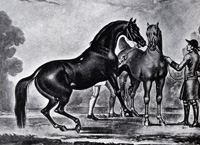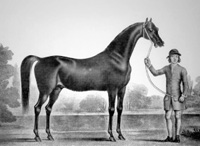 |
|
| . | |
| Mosco Orientals | |
| . | |
 Cullen Arabian  Wilson's Arabian  Wilson's Chesnut Arabian |
There are a number of oriental imports associated with Mr Mosco (variously spelled Moscoe, Moscow, Musgrave &c) who is also referred to as "the Turk". Whilst several of these horses appear to have come from Constantinople it is not particularly clear whether it is Mr Mosco or the horses which originate in Turkey. None of the horses are designated as Turks. Although the Turf Register notes that the Cullen Arabian was bred in the Royal Stud of Morocco this is apparently a casual mistake made by misreading a list of advertised stallions [Pick 1:132]. The Arabians in question were either shepherded by Mr Mosco via Constantinople, perhaps under the auspices of the Levant Company, or directly to England from their country of origin around 1744. This is supported by an advertisement in Cheny that notes that the Mosco Grey Arabian "was with five others that are sold, brought by Mr Moscow from Constantinople" [Cheny:1750]. |
| Cullen Arabian | |
|
br c 1740. Sire Line
Cullen Arabian. A notable broodmare sire, he sired the unnamed dam (b f 1756) of the Old England Mare (b f 1766) the modern taproot mare of Family 2-t and ancestress of a host of grand performers and stallions such as the Champion Sire Blacklock (b c 1814 Whitelock), Sir Hercules (bl c 1826 Whalebone), the Derby winner Teddington (ch c 1848 Orlando) and the St Leger winner St. Albans (ch c 1857 Stockwell). Another unnamed daughter (f 1749) became the ancestress of the St Leger winner and champion sire Filho da Puta (br c 1812 Haphazard). In Virginia his influence was widespread. He sired Aristotle* (br c 1755) who sired the matron Brandon (f 1765), who in turn became the dam of a number of important early sires, including Meade's Celer (c 1776 Janus*), Clodius (b c 1778 Janus*), and Quicksilver (gr c 1783 Eppes's Mercury). The Cullen Arabian also got Little Skim* (br c 1756). His daughter Spotswood's Diana* (gr f 1754) the taproot mare of Family 12-b proved to a gem. Before export to America she produced the dam of Conductor (ch c 1767) a link in the Matchem sire line and his brother, the Clermont Cup winner Alfred (b c 1770). Diana*, sometimes erroneously called Duchess or Diamond, also produced Spotswood's Apollo (b c 1767 Fearnought*), Fitzhugh's True Whig (ch c 1775 Fitzhugh's Regulus), and the unnamed mare (f 1766c) by Jack of Diamonds* who became the ancestress of Lexington (b c 1850 Boston).
The Cullen Arabian died at Rushton in 1761.
Camillus (GB) |
|
| Fletcher's Arabian | |
|
[Vane's Arabian] ch c 1730c.
Sire Line Fletcher's Arabian. Owned by the Hon Morgan Vane (1706-1779) of Bilby Hall, Nottinghamshire he was advertised as the "least of the two Chesnut Arabians brought over by Mr Mosco" which presumably refers to his height. He covered in Lincolnshire at Stocking Hall and in Nottinghamshire near Blythe for a fee of five guineas. He got several race horses under the name of Vane's Arabian including the colourfully named Naggy Grievous (ch f 1738) who finished third for the Hambleton Royal Plate in 1743. Others include Cyrus (gr c 1747), Fashion (ch c 1751c) and Delicate Nell (ch f 1752). All of his stud book offspring were credited to the name of Fletcher's Arabian which probably refers to Henry Vane-Fletcher (d1761) of Hutton Hall. These included the runners Shrimp (b c 1738), Warrior (b c 1739) and Yellow Jack (ch c 1739). Interestingly the colour of Yellow Jack is specifically stated to be yellow in Baily's Racing Register [68]. None of the stud book entries bred on past the third generation. |
|
| Mosco's Grey Arabian | |
|
[Moscoe, Musgrove] gr c
1740c. Sire Line Mosco Grey Arabian. He was imported into England from Constantinople along with the Cullen Arabian in the autumn of 1744. Described as a most beautiful and strong horse Mr Mosco refused 500 guineas for him [Cheny 1750, 115]. He was said to be healthy, blemish-free and allowed by horsemen as likely to sire good runners as any horse. Covering in Surrey at Barrow Hedges near Croyden in the hands of Mr Trewhit he initially commanded a fee of ten guineas although in his later years he stood for William Moodey at the Salutation in Doncaster for three guineas. He sired Queen Mab* (gr f 1745c) whose American descendants include Hopper's Pacolet (gr c 1740c Spark*), Hayne's King Herod (b c 1768 Fearnought*) and Young Bulle Rock (b c 1773 Hunt's Bulle Rock). He also got the unnamed mare who became the dam of Moore's Britannia* (b f 1750 Hampton Court Dun Barb) herself the second dam of Ashe's Roebuck (br c 1780c Sweeper*). |
|
| Phillips's Arabian | |
| b c 1740c. Sire Line
Phillips's Arabian. Owned by Sir John Phillips (1701c-1764), 6th Bt, of Picton Castle, Wales he was invariably described as a beautiful bright bay remarkable for getting large sized foals of his own model and colour. He does not appear in the General Stud Book. He covered in Surrey at Norbiton Place near Kingston for a fee of five guineas. He left no offspring in the stud book. |
|
| Trout's Arabian | |
| ch c 1740c. Sire Line
Trout's Arabian. Advertised as the strongest, highest bred and finest horse in England he covered under the stewardship of Samuel Trout in Lincolnshire at South Elkington, near Louth for a fee of two guineas. He is not recorded in the General Stud Book. He left no offspring in the stud book. |
|
| Wilson's Bay Arabian | |
|
b c 1740c. Sire Line
Wilson's Bay Arabian. This horse is not mentioned in the General Stud Book. Described as a fine bay Arabian standing nearly 15 hands he was said to have been brought from Constantinople by Mr Mosco. In the hands of Mr Charles Wilson he covered in London at Hyde Park Corner for a fee that rose from one to three guineas and later at Newport in Monmouthshire also for three guineas. He was last advertised in 1754 to cover at Mr Dunn's along with Wilson's Chesnut Arabian (below) for a fee of two guineas. He left no offspring in the stud book. |
|
| Wilson's Chesnut Arabian | |
| ch c 1745c. Sire Line
Wilson's Chesnut Arabian. This horse was not one of the Mosco Arabians although his provenance may sound somewhat similar. The General Stud Book notes that "Wilson's Chesnut Arabian (really a Turk), was brought to England by Lord Kinnoul, from Constantinople, where he cost 200 guineas" [GSB 1:394]. George Henry Hay (1689-1758), 8th Earl of Kinnoul, was British Ambassador at Constantinople from 1729 to 1737. His spouse Abigail was the daughter of Robert Harley (1661-1724), 1st Earl of Oxford. On the other hand Fairfax Harrison notes that on the back of the Houston print of the Wilson Chesnut Arabian are the words "Chesnut Arabian, imported into England by Fitzhugh, Esq., and the property of Mr Chas. Wilson" which implies that Mr Fitzhugh imported the horse and then sold him to Charles Wilson. However Harrison then goes on to incorporate Mr Mosco as a partner to Fitzhugh and to include the Chesnut Arabian in the Mosco group of importations. Fitzhugh may have been William Fitzhugh who was employed by the Levant Company in Aleppo between 1735 and 1751. In any case the Chesnut Arabian ended in the hands of Charles Wilson and stood for several seasons at Mr Dunn's in Yorkshire at Oran, near Catterick for a fee of five guineas. He was described as a fine type, highly bred and powerful. He sired a number of runners although his most significant offspring was the third dam of the Doncaster Cup winner Abba Thulle (b c 1786 Young Marske) and his half brother Arra Kooker* (br c 1789 Drone). There are presently more than twenty-five known offspring of the Wilson Arabian and perhaps some of them should be credited to Wilson's Bay Arabian (above). |
|
| Wilson's Arabian | |
| c 1735c. There is some evidence which indicates the presence of yet a third Wilson's Arabian, this one owned by Thomas Wilson and covering at Navestoke, near Brentwood in Essex. This horse was advertised in a sale of the Wilson stud in 1742 and said to be a "very fine Arabian, brought over by the Earl of Kinnoul, late Embassador at Constantinople; where he cost above £200 Sterling, and is esteemed as true high bred an Arabian, as ever came to England, a very compact Horse, and exceeding strong of the kind". It seems possible that this Arabian was somehow confused with Wilson's Chesnut Arabian. |
|
|
|
|
| . | |